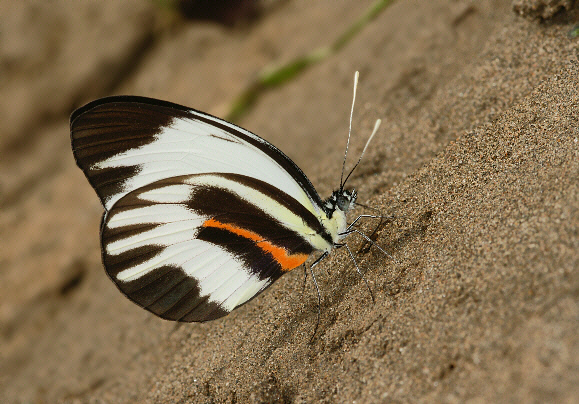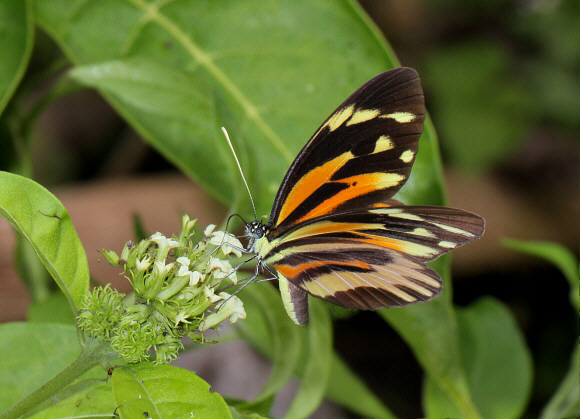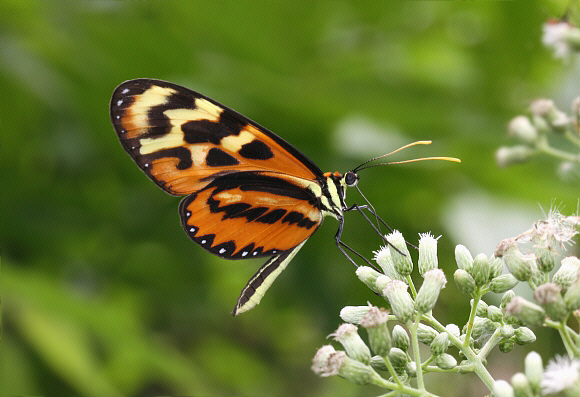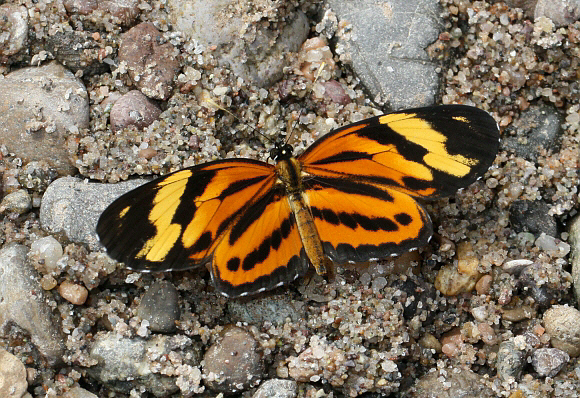As discussed previously, unpalatable butterflies often have prominent patterns. Experiments have shown that some avian predators can memorise these patterns and learn to avoid eating similarly patterned species in the future.
Batesian Mimicry
The 19th century naturalist Henry Walter Bates realised that many species which were palatable to birds had uncannily similar patterns to unrelated toxic species. An often quoted example illustrated below is the palatable North American species Limenitis archippus which bears a quite remarkable resemblance to the highly toxic Monarch butterfly Danaus plexippus. Recent research however has shown that both of these species are unpalatable, thus they are Mullerian mimics , not Batesian mimics.
There are nevertheless numerous other examples of true Batesian mimicry such as the palatable Dismorphia and Heliconius species which mimic toxic Ithomiines; and the palatable Spicebush Swallowtail Papilio troilus which mimics the toxic Pipevine Swallowtail Battus philenor.
Bates published a scientific paper in 1862, in which he theorised that palatable species occasionally produced mutant forms with visual characteristics similar to toxic species. He believed that they would therefore be less likely to be killed by birds, and would pass on their characteristics to their offspring. He proposed that as a result of further mutations over the millennia, that palatable species had evolved to become almost identical to the toxic species.
This form of defence is widely known as Batesian mimicry. It is normally only effective because the toxic species far outnumber the non-toxic species. If the situation was reversed so that most of the butterflies attacked were palatable, the mimicry bluff would fail.
There are however circumstances where the mimic can outnumber the model, and the bluff will still work. An example is Eresia pelonia which produces several differently coloured forms or morphs, each mimicking a different toxic model e.g. the nominate subspecies E. pelonia pelonia is a mimic of the Ithomiine Callithomia alexirrhoe thornax; while subspecies Eresia pelonia callonia is a very close “copy” of Hypothyris mansuetus meterus. For any form of mimicry to work, both the mimic and the model must fly together in the same area, i.e. they must be sympatric.
Another example is the Mocker Swallowtail ( aka the Flying Handkerchief ) Papilio dardanus, which produces several mimetic forms. Such species are known as mimetic polymorphs. In the case of dardanus all males look identical, but the female produces several morphs. These correspond to a variety of different unpalatable models including Amauris niavius, Amauris echeria, Acraea poggei and Danaus chrysippus.
The reasons why only females produce polymorphs is poorly understood. Some biologists postulate that if males also produced polymorphs that certain morphs would be disadvantaged during male / male territorial conflicts. If this was the case the “losing” morph would end up holding lower quality territories, reducing their chances of intercepting females.
A further example is Perrhybris pamela – on the upperside of the wings the males are white with a black apex, but females are entirely different, patterned with bands of orange, yellow and black. The females are generally regarded as Batesian mimics of Ithomiines in the genus Mechanitis.
 Perrhybris pamela, male, Rio Madre de Dios, Peru – Adrian Hoskins
Perrhybris pamela, male, Rio Madre de Dios, Peru – Adrian Hoskins

Perrhybris pamela, female, Satipo, Peru – Adrian Hoskins
 Mechanitis polymnia dorissides, Rio Pindayo, Peru – Adrian Hoskins
Mechanitis polymnia dorissides, Rio Pindayo, Peru – Adrian Hoskins
Müllerian mimicry
In 1879, Müller realised that there were also many cases where both the mimic and the model were unpalatable. When a bird catches any one of these butterflies, either model or mimic, and realises it is unpalatable or toxic, it quickly learns to keep away from all similarly patterned species.
This type of evolutionary “cooperation” is referred to as Müllerian mimicry, and is a very common phenomenon amongst the Ithomiinae, Danainae and Pieridae. Müller demonstrated mathematically that this form of mimicry is biased in favour of the scarcer species by a factor of the square of the ratio of species abundance. It is advantageous for there to be a large number of species involved in a Müllerian mimicry complex as it increases the power of the warning signal.
It is important to note that mimicry cannot be simply categorised into groups of distasteful models and Batesian or Mullerian mimics. There is actually a broad spectrum of palatability from species to species, and within any given species. Many butterflies only become unpalatable after sequestering toxins from plants, so when they first emerge they are palatable, but after a few days feeding they become unpalatable.
Birds and other predators must also vary considerably in what they find palatable – a tanager for example might be find a particular species of butterfly to be unpalatable, but a jacamar might find it quite acceptable.
The Tiger complex
A famous example of butterfly mimicry is the “tiger complex” – a group of about 200 neotropical species which all share a similar pattern of orange and yellow stripes on a black ground colour.
The complex includes many unpalatable Ithomiines such as Tithorea harmonia, Tithorea tarricina, Melinaea marsaeus & Forbestra equicola, unpalatable Danaines such as Lycorea pasinuntia, and several highly toxic day-flying moths from the Arctiid subfamily Pericopinae. It also includes many unrelated species that are considered to be palatable e.g. Heliconius ismenius, Heliconius hecale, Eueides isabella ( Heliconiinae ), Eresia eunice ( Nymphalinae ), Stalachtis calliope ( Riodinidae ), Consul fabius ( Charaxinae ) and Pterourus zagreus ( Papilioninae ).
Members of the tiger complex habitually aggregate in large numbers in damp gullies in the forest at the end of the dry season. It is at this time when they are very docile and easy prey for birds, that mimicry has its greatest potential as a defence mechanism. Any bird that suffers the unpleasant experience of tasting a member of the tiger-complex quickly learns to avoid attacking any similar looking species, and may even be capable of communicating their distasteful nature to other birds.
 Eresia eunice ( Nymphalinae ) – Adrian Hoskins
Eresia eunice ( Nymphalinae ) – Adrian Hoskins
 Eueides isabella dissoluta ( Heliconiinae ) – Adrian Hoskins
Eueides isabella dissoluta ( Heliconiinae ) – Adrian Hoskins
Mimicry rings
Although the “tiger complex” is the most well known group of mimics and models in South America, there are a number of other mimicry rings. The “glasswing ring” is a group of largish transparent species that includes toxic Mullerian models in the Ithomiine genera Methona and Thyridia, a toxic Danaine Lycorea ilione, and a Batesian mimic – the palatable Dismorphiine Patia orise. The “orange ring” is comprised of a group of bright orange species including Marpesia petreus, Dryas iulia and Eueides aliphera.
Additionally there are several species pairs, the most well known of which is Heliconius erato and Heliconius melpomene. These species each produce 29 different geographically isolated subspecies. For each subspecies of erato, there is an equivalently patterned melpomene subspecies.
Why so many mimicry rings? The answer in the case of Ithomiines is vertical stratification of their forest habitats. The smaller glasswings regardless of genus tend to fly and utilise foodplants in the lower understorey. Tigers occupy the layer between about 2-4 metres above ground level. Other groups inhabit progressively higher layers, right up to the sub-canopy. In the case of genera such as Heliconius, which all tend to fly at roughly the same height, Mullerian mimicry complexes are apparently segregated horizontally by vegetation type.
Wasp mimicry
Many day-flying moths in the family Sesiidae have small transparent wings, and bodies banded in yellow and black. They bear a remarkable resemblance to wasps and hornets, and almost certainly escape predation as a result of their similarity to these stinging insects.
In the neotropical region there are dozens of Arctiid moth species in the genera Cosmosoma, which have transparent wings and boldly patterned red, orange, or yellow bodies. Most are nocturnal in behaviour and hide away amongst foliage in the daytime, so unlike members of the tiger-complex they don’t actively advertise their bold patterns to predators. It seems likely however that many are chanced upon by foraging birds, and that at such times their threatening appearance may save them from being devoured.
 Cosmosoma species ( Arctiidae : Ctenuchini ), Manu cloudforest, Peru – Adrian Hoskins
Cosmosoma species ( Arctiidae : Ctenuchini ), Manu cloudforest, Peru – Adrian Hoskins
Transformational mimicry
Mimicry is not just confined to adult butterflies and moths. Many palatable caterpillars also mimic unpalatable species. Caterpillars often change their appearance periodically after moulting, and it can happen that a caterpillar can mimic different models during different instars. Furthermore the adult butterfly or moth that ultimately results from that caterpillar could mimic yet another species. This is known as transformational mimicry. There are many other forms of mimicry known.
A note of caution
It is very easy to make assumptions about mimicry that may not prove valid. Not all examples of apparent mimicry are genuine cases. There are numerous examples of almost identical butterflies occurring on opposite sides of the world. Such similarities cannot be attributed to mimicry, so how did they come about ?
The biological mechanisms & processes which generate wing patterns are fundamentally the same for all butterfly and moth species. It is therefore logical to assume that similarities will commonly occur amongst unrelated species, particularly where they evolve in similar habitats, where the mechanisms are affected by the same climatic and environmental factors.
It is obvious for example that many moth species across the world will have evolved to look like green leaves, or like bits of lichen or patches of tree bark, because these occur in all habitats, and the moths need a convincing camouflage when they settle on them. It is highly unlikely however that these near identical moths share common predators. Clearly these are simple cases of convergent evolution, but nothing whatsoever to do with mimicry.
